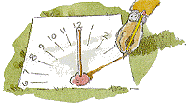
Paulette Bourgeois. Illustrated by Bill Slavin.
Toronto: Kids Can Press, 1995. 40pp, cloth, $14.95.
ISBN 1-55074-158-6.
Subject Headings:
Sun-Juvenile literature.
Sun-Experiments-Juvenile literature.
Grades 2 - 5 / Ages 7 - 10.
Review by Harriet Zaidman.


 The Sun is a well-written science book for children by the
author of both the "Franklin" (the turtle) series and other science titles:
The Amazing Potato Book, The Amazing Apple Book, and
The Amazing Paper Book. The Sun is part of a
series called `Starting with Space' (which also includes The Moon).
The Sun is a well-written science book for children by the
author of both the "Franklin" (the turtle) series and other science titles:
The Amazing Potato Book, The Amazing Apple Book, and
The Amazing Paper Book. The Sun is part of a
series called `Starting with Space' (which also includes The Moon).



 Copyright © 1995 the Manitoba Library Association.
Reproduction for personal use is permitted only if this copyright notice is
maintained. Any other reproduction is prohibited without permission.
Copyright © 1995 the Manitoba Library Association.
Reproduction for personal use is permitted only if this copyright notice is
maintained. Any other reproduction is prohibited without permission.